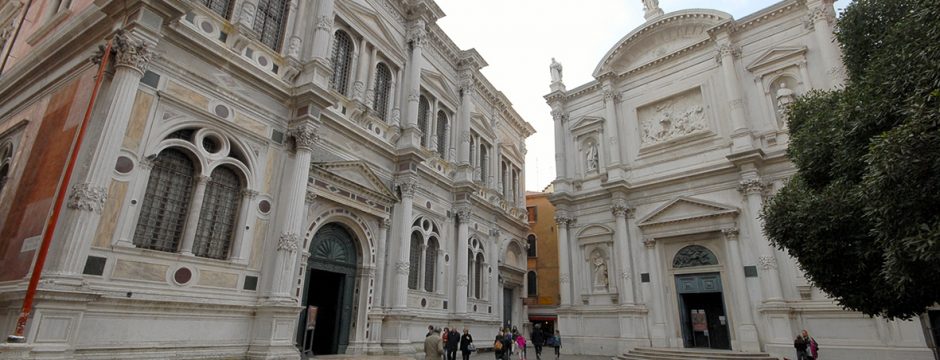The visit of the Frari church and the School of san Rocco is a must for any visitor interested in Venetian art.
The huge Franciscan Church dedicated to the Assumption of Mary (Santa Maria Gloriosa dei Frari) epitomizes the close bonds between noble families and the Franciscan Order. This was a premium place for the wealthiest Venetian families to be buried in monumental tombs and to entrust to the Franciscans Friars the good care of their souls in the afterlife after substantial donations.
A series of impressive altarpieces are still in situ by their altars. The largest one was painted by a young Titian to decorate the main altar and dedicated to the ‘Glory of Mary’ or ‘Her Assumption’. Titian left his genial mark again when he painted another large altarpiece for the ‘Pesaro family’ representing all the male members by the Virgin and Child.
Another masterpiece not to be missed is the altarpiece that Giovanni Bellini painted in 1488 for the tomb of another branch of the Pesaro family where the four male members stand on both sides
of the Virgin Mary and her Child.
But the Frari Church has more to offer; an original work by Donatello, other altarpieces by the distinguished Vivarini workshop and statues including one by Alessandro Vittoria plus the most flamboyant reliquary ever made in Venice and a precious marble rood screen standing by the choir.
By viewing all these works you can learn about the life and deeds of the great Venetian families and get an insight into the history of Venice in 15th and 16th centuries.
The ‘Scuola’ or School of San Rocco was the wealthiest brotherhood in Venice and it shows. It was instituted to be a mutual support society with the goal to provide assistance to its members in case of need, it proved to be of enormous help during the plagues of 1575/1576 and 1630/1631.
The building was lavishly decorated both in its architecture and its interior. It was primarily a showcase of the wealth and pride of that class of business men and high-end artisans that were disenfranchised from political rights which were an exclusive privilege of the nobleman.
This building therefore is the best place where to summarize the main activities of brotherhoods and the crucial role they played in Venetian society.
The artistic part of the tour is centered almost exclusively on Tintoretto the last of the greatest painters of the 16th century, all the wall paintings and those of the ceiling in the large assembly room were produced by him and his family workshop.
He was first appointed to decorate the room of the Managing Board in 1564 and it is here you’ll see his grandiose ‘Crucifiction’ and the ‘Episodes of the passion of Christ’. The next step and the most demanding was the painting of 25 large canvasses decorating the ceiling and the walls of the Upper room with scenes of the life of Christ and three episodes of the Exodus including ‘Moises striking water from the rock’.
He completed the commission in 1587 after painting eight more large canvasses in the Lower room.
During this tour your guide will examine a selection of works and introduce you not just to the art of Tintoretto but also to the social, political and artistic trends of his time.
2018 marks the quintecennial of Tintoretto’s birth.


